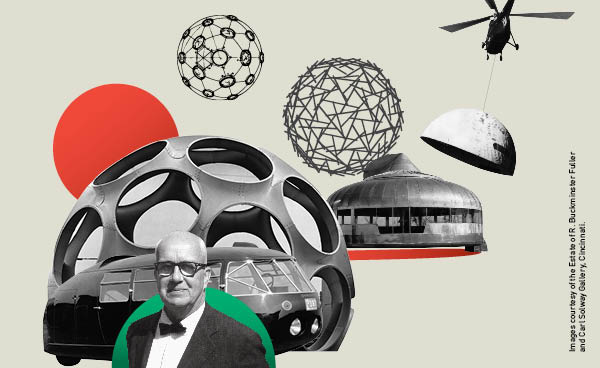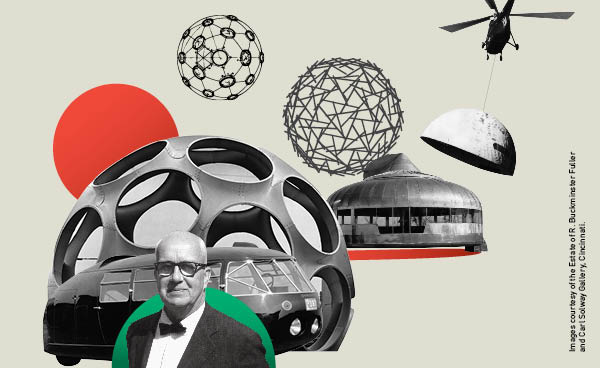
EXHIBITION
Radical Curiosity:



EXHIBITION
Radical Curiosity:
In the Orbit of Buckminster Fuller
E-tickets can be purchased here.
“My ideas have undergone a process of emergence by emergency. When they are needed badly enough, they are accepted” – Buckminster Fuller (1885 – 1983)
Radical Curiosity: In the Orbit of Buckminster Fuller is a journey through the universe of an unclassifiable investigator, inventor and visionary. Buckminster Fuller worked across multiple disciplines including art, architecture, design, engineering, metaphysics, mathematics and education.
Ahead of his time, he devised a way to combine design and science with a mission to change the world, to make our planet work at 100% of its capacity for 100% of the population, in cooperation, without causing harm.
Fuller’s collaborations with some of the 20th century’s major creators, thinkers, architects and artists has continued to inspire contemporary innovations across multiple disciplines. Fuller foresaw the many global crises humanity faced during his lifetime and he worked tirelessly to guide us as ‘passenger-caretakers' in what he called “our spaceship Earth”.
An ArtScience Museum co-production with Fundación Telefónica, Madrid and guest curators Rosa Pera and José Luis de Vicente.
![]() Admission Times
Admission Times
(Last admission at 6pm)
Ticketed Admission
Singapore Residents:
Adult: S$18, Child: S$14
Tourists:
Adult: S$21, Child: S$16
Additional ticket options available
Ticketed Admission
Explore the Exhibition
-

Personal Chronofile
-

Design Revolution
-

Make Your Life An Experiment
-

Geodesics
-

Tensegrity
-

Shelter
-

Information
-

Everything We Know
-

Spaceship Earth
-

Moshe Safdie
-
Design Revolution
Buckminster Fuller defined himself as a “Comprehensive Anticipatory Design Scientist”, a scientific designer and a design scientist, who was able to foresee solutions based on his comprehensive knowledge of the universe. He sought to change the world through a “design revolution” that would result in the radical and systemic transformation of our understanding of the planet and how it worked. His mission: “To make the world work for 100% of humanity, in the shortest possible time, through spontaneous cooperation without ecological offense or the disadvantage of anyone.”
Bucky’s early project focused on rethinking the way we remain under cover and move from one place to another. The results were the Dymaxion House and Dymaxion Car, which would be the models for housing and automobiles for the society of the future. The Dymaxion brand name, a portmanteau of “dynamic maximum tension”, summarised his way of thinking and acting. Always experimental, his work expanded to adopt innovative strategies, ideas and methods concerning knowledge and education, physics and metaphysics, resource management and information.
Bucky’s ideas and designs serve as reference points for contemporary researchers working in the fields of art, architecture and design, aware of the wisdom of nature and the search for other ways to integrate it into their lives, often using contemporary approaches such as biomimetic design, in which design is based on the observation of nature’s processes.
Featured Artworks
4artworks-
 Buckminster Fuller, Dymaxion Car, Fly’s Eye Dome, photograph taken at Bucky’s 85th birthday in Aspen, CO, USA, 1980. Courtesy of Roger White Stoller.
Buckminster Fuller, Dymaxion Car, Fly’s Eye Dome, photograph taken at Bucky’s 85th birthday in Aspen, CO, USA, 1980. Courtesy of Roger White Stoller. -
 Dymaxion Drawing. Courtesy of The Estate of R. Buckminster Fuller.
Dymaxion Drawing. Courtesy of The Estate of R. Buckminster Fuller.
-
-
Geodesics
In the early 1950s, the various lines of Bucky’s enquiries converged in his most successful project, capturing America’s collective imagination and becoming an iconic and enduring symbol for the future: the geodesic dome.
The geodesic dome was a product of Bucky’s obsessive study of the rules of geometry. Geodesic lines mark the shortest possible path between two points on a sphere. Fuller theorised that this principle of efficiency could be used to design a stable structure. Effectively, the strength of a dome based on geodesic lines is greater than that of its separate elements. A geodesic structure is also the greatest area that can be covered with the least amount of material and can support itself without the need for foundations. It represents the culmination of the idea that more cannot be achieved with less. By the time of his death, thirty-five years later, between 100,000 and 200,000 geodesic domes had been built around the world.
In the Build-it-like Bucky Playground! there are three areas you can explore and play:
Dome
Under the dome, you will find materials you can use to create your own dome and tensegrity structure.Toys on Shelves
Interact with the toys and puzzles inspired by Fuller’s inventions and concepts.Building Activity
Using the colourful shapes and sticks stored in the crate boxes, build a play structure for everyone to enjoy!Learn and be inspired by Bucky’s wonderful ideas and creations!
Children must be supervised by an adult at all times*
Featured Artworks
4artwork-
 Courtesy of ArtScience Museum and Marina Bay Sands
Courtesy of ArtScience Museum and Marina Bay Sands -
 Photograph of Buckminster Fuller’s Montreal Expo 67 dome. Courtesy of The Estate of R. Buckminster Fuller.
Photograph of Buckminster Fuller’s Montreal Expo 67 dome. Courtesy of The Estate of R. Buckminster Fuller.
-
-
Tensegrity
Of central importance to Fuller was the notion of “synergy”, connecting his vision of the universe to ideas about sustainability.
Synergy is the behaviour of complete systems, which cannot be predicted from the behaviour of any of their separate parts on their own. For Fuller, synergy was vision and methodology:
“The universe is a synergy of synergies. It is a corollary of synergy that the known behaviour of wholes plus the known behaviour of a few of their parts enables discovery of other parts and their behavioural characteristics. In order to really understand what is going on, we have to abandon starting with parts, and we must work instead from the whole to the particulars (…) There is nothing that one does that does not affect all others in varying degrees. This, of course, includes all life.” Buckminster Fuller.
In order to visualise this idea in functional forms, Fuller applied geometry, creating another of his key concepts, “tensegrity”, a portmanteau of “tension” and “integrity”. Tensegrity consists of the suspension of rigid elements in space solely through continuous tension and discontinuous compression. He designed building elements such as the Octet Truss and Tensegrity Mast, synergetic systems that materialised the fourth dimension, this is, time and space.
Featured artworks
4artworks-
 Buckminster Fuller, Geodesic Tensegrity Sphere, 30 Strut. Edition 6 of 10, 1980. Courtesy of Carl Solway Gallery, Cincinnati.
Buckminster Fuller, Geodesic Tensegrity Sphere, 30 Strut. Edition 6 of 10, 1980. Courtesy of Carl Solway Gallery, Cincinnati.
-
-
Shelter
From the outset of his career, Buckminster Fuller was convinced that the swiftest way to change society was through the reinvention of housing. By the early 20th century, industrialisation had transformed every aspect of daily life. Nevertheless, the form and function of houses and the way we live in them essentially had not changed.
The house of the future would be self-sufficient in terms of energy in order to be free of supply networks and to free occupants from the slavery of domestic drudgery thanks to new automation technologies.
The most radical of his inventions was based on his belief that houses should be mobile, meaning that their location could be changed as quickly as people’s circumstances can. In a world where houses lost their non-negotiable ties to the ground they were built on, ownership of land would become "something as devoid of meaning as the idea of the ownership of the sea is to a boat”.
One hundred years after Bucky expressed his ideas regarding the reinvention of the home, all of the world’s major cities are suffering a crisis of access to housing. Reimagining “shelter technologies” in order to make housing accessible, affordable and sustainable is one the greatest challenges we face today.
Featured artworks
4artwork-
 Buckminster Fuller and Shoji Sadao, Dome over Manhattan, photograph, 1960. Courtesy of The Estate of R. Buckminster Fuller.
Buckminster Fuller and Shoji Sadao, Dome over Manhattan, photograph, 1960. Courtesy of The Estate of R. Buckminster Fuller.
-
-
Information
Fuller felt that the source of many of our world’s problems lies in our inability to detect patterns of activity in society. He proposed that if we knew enough to understand how the world’s resources are distributed, it would be much easier to determine a reasonable solution for everybody.
In his constant search to find ways that the world might work through a design-science duality, in the 1930s Bucky sought to create large databases which we could analyse - thanks to the new possibilities offered by computers - and process large amounts of information that would allow us to make better decisions. He saw the need to create new visual codes to represent the world’s complexity, including a new cartography that allows us to depict the planet without pre-conceived – and often wrong – ideas of north and south, east and west.
Various decades before technology made it possible, Fuller foresaw the contemporary discourse offered by Big Data and the visualisation of information, and by the logic of gamification, which uses the mechanics of games to tackle complex problems.
Featured Artworks
4artworks-
 Buckminster Fuller, “How to assemble the globe”. LIFE Magazine March 1943. Courtesy of The Estate of R. Buckminster Fuller.
Buckminster Fuller, “How to assemble the globe”. LIFE Magazine March 1943. Courtesy of The Estate of R. Buckminster Fuller.
-
-
Everything We Know
ArtScience Museum and Fundación Telefónica commissioned Milan-based design studio, Studio Folder with Angelo Semeraro, to create a new installation for the exhibition. Everything We Know takes its title from the 1975 epic, 42-hour lecture marathon by Fuller, Everything I Know, while combining the four cornerstones of Fuller’s oeuvre: the Dymaxion map, the World Resources Inventory, the Geoscope, and the World Game. Everything We Know invites the visitor to take part in an atemporal conversation with Fuller and an assembly of contemporary scholars, thinkers and practitioners in the fields of architecture, design, art, political science, scientific and technical studies, social sciences and economics. Their contributions to debates around today’s most pressing issues have been scraped from online sources and paired to more than 300 publicly available datasets through a semantic mesh.
The projected data—rendered as dynamic dot maps—show a global distribution of resources, networks and infrastructures across continents and ecosystems: from rare earth reserves, to global forest loss, Amazon warehouses, wind farms, supercomputers, and more. The installation harnesses and questions Fuller’s aspiration, that is to solve the world’s problems through conversation and data: the more we know, the more tools we have to address inequalities and conflicts.
Featured Artworks
4artworks-
 Studio Folder and Angelo Semeraro,
Studio Folder and Angelo Semeraro,
Everything We Know, 2020–2022. Data visualisation, Courtesy of ArtScience Museum and Marina Bay Sands
-
-
Spaceship Earth: Education Activity
Fuller felt that we are all passengers of Spaceship Earth, with an innate ability to understand the universe and how its systems work. He saw it essential to eradicate educational programmes that repress curiosity and our natural inclination to experimentation.
Instead, he favoured an “educational metabolism” based on the transfer of specialist knowledge to all children and young people through technologies that promoted concentration and communication. He planned to build individual cubicles from where students could have access to audiovisual materials prepared by specialists based on research by renowned scientists, architects and philosophers. These cubicles would have community television systems (which he called “Two-Way TV”) and a permanent telephone link to the tutor. He thought the cubicles should also include two Fullerian inventions: the Geoscope and the Dymaxion Map.
In this gallery is an open call for contributors.
Visitors can be part of the Spaceship Earth crew by contributing a job or role for our shared project. Visitors will display their imagined future job in the gallery.
Featured Artworks
4artworks-
 Render view of Spaceship Earth: Education Activity, ArtScience Museum.
Render view of Spaceship Earth: Education Activity, ArtScience Museum.
-
-
Make Your Life An Experiment
Of all of Buckminster Fuller’s projects, the most ambitious one was building his own myth. Like the story of a comic superhero, the legend of Bucky (his familiar name for those that knew him) began at a crucial time in which his life changed and he was reborn as a new person.
After a tragic event, Fuller embarked on a period of profound introspection during which he did not speak for two years, frenetically writing five thousand pages that would become the first ideas of his career. This is just one of the many colourful stories that embellished his interviews and conferences over decades; in others, he claimed that he only needed two hours sleep per day. A complex and controversial man, Fuller explored many ideas and processes over his life, which he then developed into theories and experiments that had a massive reach.
There are many exaggerated stories associated with the Bucky myth and yet this myth was an instrument through which he constructed an image of a visionary entrepreneur in order to transmit a powerful idea: without the need to be anything special, we can all do exceptional things.
Featured Artworks
4artworks-
 Wot Studio, Dymaxion Chronofile Visualisation, 2020. Video installation. Courtesy of Stanford University Libraries
Wot Studio, Dymaxion Chronofile Visualisation, 2020. Video installation. Courtesy of Stanford University Libraries
-
-
Personal Chronofile: Education Activity
To augment the experience of Radical Curiosity: In the Orbit of Buckminster Fuller, visitors of all ages may choose to trace Bucky’s key inventions and explore his major discoveries through creating their own Personal Chronofile.
This folder was inspired by Buckminster Fuller’s Dymaxion Chronofile. The Dymaxion Chronofile was an attempt to document his life as completely as possible. He created a large scrapbook in which he documented everything he did and thought at 15-minute intervals, from 1920 to 1983. The scrapbook contained copies of letters, bills, notes, sketches, and clippings from newspapers. This meant Bucky’s life was the most exhaustively documented lives of the 20th century.
The Personal Chronofile leads our visitors through a series of guided activities.
The Personal Chronofile is available as part of Radical Curiosity: In the Orbit of Buckminster Fuller bundled tickets. It can be purchased at the museum for S$8.
Featured Artworks
4artworks-
 Drawing. Courtesy of The Estate of R. Buckminster Fuller.
Drawing. Courtesy of The Estate of R. Buckminster Fuller. -
 Image of the Personal Chronofile in-gallery Education Activity
Image of the Personal Chronofile in-gallery Education Activity -

-
-
Moshe Safdie
Architect Moshe Safdie reflects on his 50 year career in architecture and describes Buckminster Fuller's influence on his work and thinking. ArtScience Museum, Marina Bay Sands and Jewel Changi Airport are icons of the Singapore skyline all designed by Safdie. In this interview, Safdie describes meeting Fuller in 1967 when Bucky was building the Montreal Biosphere for Expo'67. He also describes Fuller's 'lightness of being' approach to architecture and how this continues to be one of the key inspirations in his work.Featured Artworks
4artworks-

 Moshe Safdie. Interview. Video. 20 minutes. Courtesy of Safdie Architects and Marina Bay Sands.
Moshe Safdie. Interview. Video. 20 minutes. Courtesy of Safdie Architects and Marina Bay Sands.
-
Online Talks
-

Remembering Fuller with Datuk Seri Lim Chong Keat
Pioneer architect Datuk Seri Lim Chong Keat unfolds the regional story of Buckminster Fuller through the more than decade-long friendship which they shared.
View details
-

Radical Curiosity: Curators in Dialogue with Rosa Pera and José Luis de Vicente
Presented by Rosa Pera and José Luis de Vicente (guest curators of Radical Curiosity), the inaugural lecture takes us through the universe of the unclassifiable investigator and visionary who, throughout the 20th century, foresaw the major crises of the 21st century.
View details -

The Future is Always First an Idea – Charu Kokate
Charu Kokate (Partner at Safdie Architects and Director of the Singapore office), who led on and oversaw the construction of iconic and complex structures including Marina Bay Sands Integrated Resort, Jewel Changi Airport and Sky Habitat Residential Towers, headlines the second session in an online talks series accompanying Radical Curiosity: In the Orbit of Buckminster Fuller.
View details -

Remembering Fuller with Datuk Seri Lim Chong Keat
Pioneer architect Datuk Seri Lim Chong Keat unfolds the regional story of Buckminster Fuller through the more than decade-long friendship which they shared.
View details
-

Radical Curiosity: Curators in Dialogue with Rosa Pera and José Luis de Vicente
Presented by Rosa Pera and José Luis de Vicente (guest curators of Radical Curiosity), the inaugural lecture takes us through the universe of the unclassifiable investigator and visionary who, throughout the 20th century, foresaw the major crises of the 21st century.
View details

Be a Crew Member on Spaceship Earth Contest
Spaceship Earth needs your ideas! Stand a chance to win a 2D1N staycation!

Virtual Tour: Radical Curiosity

Virtual Kids Tour: Radical Curiosity

Exhibition Curators
Rosa Pera
Rosa Pera is based in Barcelona, Spain.
Independent curator and researcher focused on the strength of design as a transformation operating system through community action and its relationship with fields of knowledge such as science, architecture and contemporary art.
See more
José Luis de Vicente

Our Partners
Fundación Telefónica, the social side of the digital age
You May Also Like
-
EXHIBITION
Future World:
Where Art Meets ScienceFuture World: Where Art Meets Science at ArtScience Museum is currently closed for revamp works. We apologise for any inconvenience caused.
Immerse yourself in a world of art, science, magic and metaphor through a collection of digital interactive installations.
-
-









